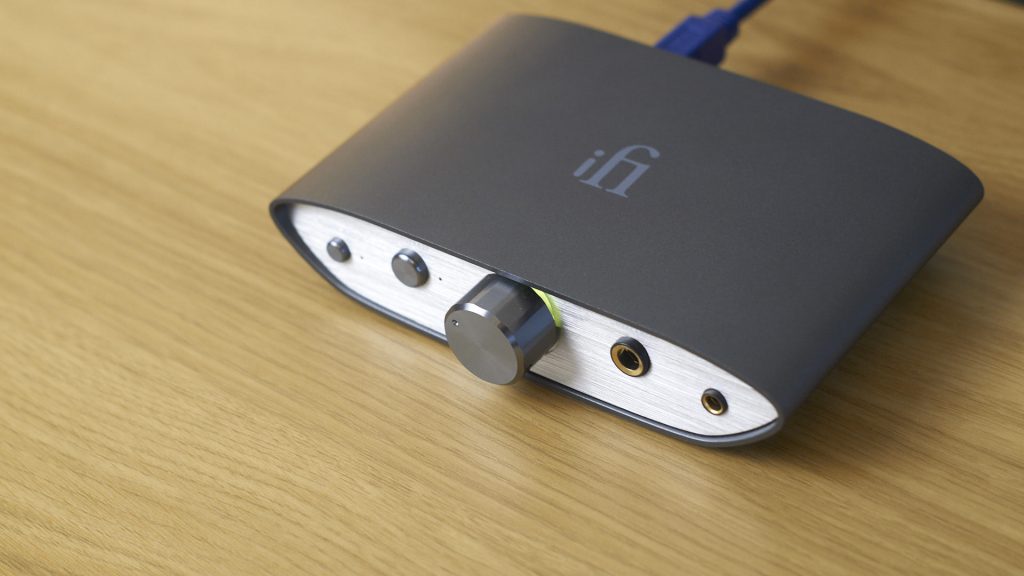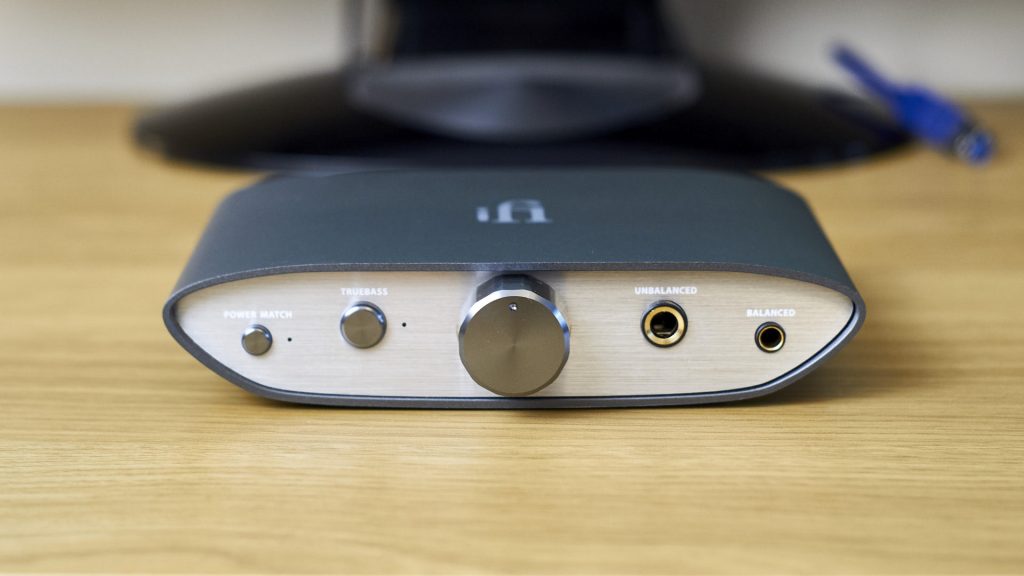iFi has just released their most budget-oriented D/A converter to date – ZEN DAC. In the heart of the device there is a Burr-Brown DSD1793 chip. For once that’s a welcome change from dominant Sabre and AK chips on the market nowadays. Spec-sheet is impressive and it basically supports all you could ever need, including native DSD and MQA up-sampling.

Curved retro styling dominates ZEN’s look.
BUILD AND FEATURES
ZEN’s body is completely made of thick aluminum and feels reassuringly hefty. The front and back plate have brushed finish, while the rest of its curved body is painted gray. Design is always a matter of taste but I think it looks stylish.
Now let’s talk a bit about connections. On the digital inputs front we have USB-B 3.1 input and that’s it. Move to outputs and there’s more to talk about as Zen DAC comes with the unusually rich offering. First of all, there’s your typical RCA out. Using a small switch beside it you can choose if you want to activate variable volume control (so you can use it as pre-amp) or bypass it and get fixed 2.1 V line out. Something more exotic is balanced Pentaconn 4.4 mm output. At this moment I have to say that all of my testings were done with single-ended output. I simply don’t own any balanced gear in my system yet.
On the front panel, the richness of outputs continues. There’s a traditional 6.35 mm headphone out, but there is a balanced Pentaconn 4.4 mm too, for those lucky owners of balanced headphones.
ZEN lights in three different colors depending on files being played. Green is for the materials up to 96 kHz. Yellow is reserved for 192 kHz or higher sample rates. Purple lights only when an MQA stream is detected. Mentioning MQA, the first level of upsampling to 96 kHz must be done in a player that supports it. Only then will ZEN be able to recognize it and upsample further to the highest 192 kHz. I’ve tried it using a Tidal app on my Windows 10 based PC and it worked flawlessly.
SOUND (RCA OUT)
Let’s start this sound quality impression with a pure line-out over RCA. ZEN sounds as detailed as any good DAC at this price point. The sound character itself is somewhat different though. First of all, it has a liquid-smooth presentation that you don’t hear often. Bass notes are deep, soft and on the warm side, but never muddy or uncontrolled. Moving to the midrange I can say it’s clean and quite transparent. Vocals sound very smooth but they’re spatially laid back a little. I found this to be pleasant and relaxing but not so involving. Some people might prefer it to the upfront presentation of many Sabre based DACs as it’s a matter of preference. Higher registers have very good resolution and sound sparkly. High frequencies are on the prominent side but never that much to be annoying. Thanks to that characteristic ZEN conveys atmosphere and air from recordings quite well.
SOUND WITH NEW FIRMWARE AND POWER SUPPLY
ZEN has one interesting feature that I was curious to try. You can go and download the latest firmware from iFi’s website, which I did. The flashing process is quick and easy. The latest 5.3c firmware brings a completely new GTO (Gibbs Transient Optimised) digital filter. ZEN will restart itself after this process and you’re good to go. A known side effect of the new GTO filter is that LED light will stay yellow no matter what format you play. I didn’t mind that one bit as long as it had a positive effect on the sound quality, which it did. Everything previously said about smooth and fluid sound still stands and that’s great. What’s even greater is that sound became snappier and more surefooted. Guitar strings had more energy and cleaner edges, while vocals were more prominent. Bass notes became a bit more focused too. I liked this change very much. It might not be huge ore life-changing but it was enough to move ZEN from very good to a great sounding device.
I was already very happy with ZEN’s performance as it is but there was just one more thing to try out. I pulled my linear power supply (DIY project based on SupperTedyReg) and hooked it to this unit. The unit restarted itself and the green LED on the back turned on. It signalizes external power supply is in use. Listening ZEN this way I noticed a subtle increase in instrument separation and body weight, as well as slightly cleaner (darker) background. Difference gained by this is not game-changing but it can be observed. I wouldn’t urge you to spend your money on a low noise power supply for this kind of gain. It’s more of extra headroom, something for enthusiasts to play when they find themselves in a need of upgrading something.
HEADPHONE OUT
Basically everything said so far goes for the headphone out too. You get plenty of details, delivered in a smooth and not-tiring manner. In comparison, DragonFly Black can sound a bit rough and unpolished. That said, the headphone-out is of very modest power. It’s best soothed for less demanding, not power-hungry models. I used it mostly in a high-gain mode as it offers a bit more dynamics and byte. The low gain mode might be needed only if you use very sensitive in-ear models.
TrueBass option is simply iFi’s implementation of the bass boost algorithm. I preferred it to be off with all of my headphones as I never liked bass boosting. Volume control is smooth and done by an analog potentiometer. That said, I haven’t experienced any channel disbalance at lower volumes.
COMPETITION
Looking at competing devices, you can certainly find more upfront sound. If you’re into more analytical approach, just look at my other DAC reviews and the likes of Schiit Modi 3 or Loxjie D10. With those you get tighter bass control and more texture in notes in general, but with them you don’t get this smooth liquid-like talent you do with ZEN. They sound dryer, and a bit more grainy.
So it’s not really a question of what’s better but what you prefer, because these DACs simply have a different approach to creating music. If you appreciate bass speed and control, texture and upfront engaging sound, you might prefer some Sabre based options. But if you like warmer, weightier and more fluid presentation, ZEN might be just the way to go.
CONCLUSION
To sum it up, iFi ZEN DAC offers great build quality, great line-out and very good but admittedly not so powerful headphone amp. Sound character is fluid, a bit laid back, with warmer bass and lively high frequencies. If those seem like traits you like in your sound and you’re in a search for a good budget DAC/AMP than ZEN should be at the top of your list.
| IFI ZEN DAC – CHARACTERISTICS |
|
D/A converter: Burr Brown DSD1793 Analog outputs: RCA single-ended, Pentaconn balanced Headphone out single-ended (6.35 mm): 1 – 3.3 V, 12 – 300 Ohms |
| IFI ZEN DAC – CHARACTERISTICS |
|
D/A converter: Burr Brown DSD1793 Analog outputs: RCA single-ended, Pentaconn balanced Headphone out single-ended (6.35 mm): 1 – 3.3 V, 12 – 300 Ohms |







The score is pretty high for this website, 9.2. Which amp/dac do you recommend then?
Topping D10 turned out to be too flat and wooden in the bass, despite decent highs. Would Schiit Magni 3+ be a better bet? It’s available at the same price! This Zen thing is nearly twice the price.
I’m not a huge fan of D10 either. I do like Schiit gear quite a bit, but if you go for Magni 3+ you still need a DAC since it’s only a headphone amp. So, in that case, Schiit Modi 3 and Magni 3 are a good match, but that takes the price up to $200. iFi Zen DAC is a DAC/AMP combo and for its price, it’s a really good one.
How do you knowi that IFI utilizies Burr Brown DSD1793?
Zen DAC format support: PCM 32 bit / 384 KHz, DSD256, DXD 384 KHz
Burr Brown DSD1793 max. 24bit/192 KHz
So it doesn’t fit together.
According to iFi, there’s a way to engineer around that factory limit, it’s not a hard limit obviously but more of a default setting. According to the info given by iFi staff over on Head-Fi.org, their engineers put their minds to it and did it.
Guys, do you know if ifi zen will pair well with the edifier 2730db? I intend to connect it to my PC but the only reviews I see are for headphones. Or if you suggest me the TOPPING E30 instead.
Thank you very much for your detailed reviews. I want to get such entry price DAC to connect my laptop to my music system via RCA. Not a big fan of bass. Like jazz, classical music.
I have all kind of records including 192khz/24 and some DSD.
Do you think this zen would be a good pic over the Topping 10s ? Or any alternative?
Thank you very much for your time !